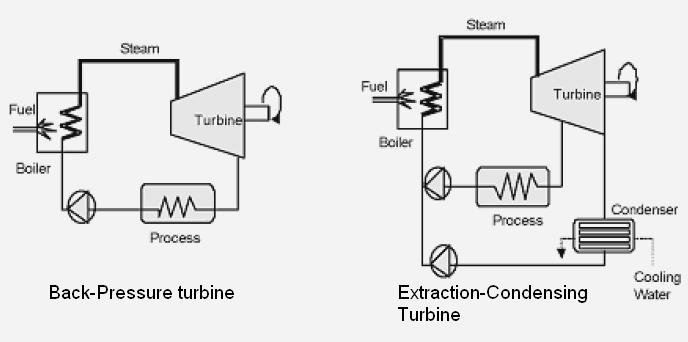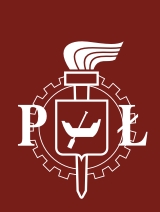
COGENERATION
TECHNICAL OPTIONS FOR COGENERATION
There are many types of cogeneration systems (also combined heat and power systems, CHP systems). The most commonly used systems are steam turbine cogeneration systems (STCS). Those systems work on Rankine’s cycle and they are very flexible in a fuel supply, they can basically use every kind of fuel that can be burnt in the boiler.

There are two types of steam turbines used in cogeneration (Figure. 6). First one is named Back-Pressure Turbine and it is characterized with simple configuration. The outlet steam exits the turbine with higher pressure than in Extraction-Condensing Turbine and flows directly to the loads where it releases heat and condenses. Except the simplicity it has more advantages, it is efficient, it uses a little or none cooling water and it is relativity inexpensive. The biggest disadvantage of that system is its inflexibility, the electricity generation is related to the production of heat and it is impossible to regulate it with independence of thermal generation.
The other type is Extraction-Condensing Turbine. Here the high pressure steam enters the turbine and when it has appropriate pressure and temperature it feeds the heating process while the rest of the steam keeps on expanding and is finally condensed. This type of plants in comparison to the Back-Pressure plants generate more electricity and are more flexible. However they need auxiliary equipments such as cooling towers and condenser. They are also more expensive and less efficient.
Another type of CHP is gas turbine cogeneration system (GTCS). Those systems have experienced rapid development in the recent years and become an alternative for steam turbine cogeneration systems. In GTCS (Figure 7) compressor concentrates the air and puts it into the combustor where it is burned. Consequently fumes leave the combustor and enter the turbine producing mechanical power to propel a generator and a compressor. Fumes leaving the turbine are hot enough to feed the thermal loads.

If more electric power is required It is possible to use Combined Gas and Steam Cycle (CGSC). Here exhaust gases that leave the turbine instead of heating the thermal loads generate steam which is consequently passed through Back-Pressure or Extraction-Condensing turbine to generate more electric power. Gas turbines as a whole are characterized with high efficiency, low emission of poisonous oxides, low investing costs and high flexibility. However high costs of gas make it uneconomic without subsidies.
Recuperating engine cogeneration system (RECS) is another technique of cogeneration. This system uses internal combustion engines to provide torque and heat with efficiency higher than in steam and gas turbines (Figure. 8). Heat can be recouped from four sources: exhaust gasses, lube oil cooling water, engine jacket-cooling water and turbocharger cooling. However, recovering heat from lube oil and turbocharger is rarely used. Obtaining heat is generally in a form of low pressure steam or hot water which later can be warmed up to medium pressure high temperature steam by exhaust gasses. RECS is an ideal solution for off-grid, low power systems as well as distributed generation. It is high efficient, very flexible and its starts very quickly thus it can be vital as a standby reserve.

The main disadvantage of RECS is its maintenance costs, they are higher than in steam and gas turbines but they can often be handled by in-house or local service.
Table 1 shows typical cogeneration performance parameters for various cogeneration systems giving electrical power, average years availability, electrical efficiency, overall efficiency and heat to power ratio.

-
Definition of energy conservation and demand side management|
Technologies|
Financial funds|
Legislative and normative issues|
Data base
Copyrights © Arkadiusz Mysiakowski
